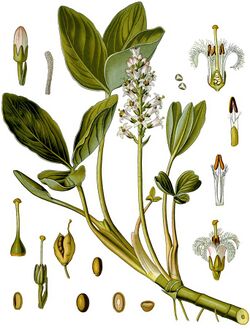Biology:Menyanthaceae
| Menyanthaceae | |
|---|---|

| |
| Menyanthes trifoliata | |
| Scientific classification | |
| Kingdom: | Plantae |
| Clade: | Tracheophytes |
| Clade: | Angiosperms |
| Clade: | Eudicots |
| Clade: | Asterids |
| Order: | Asterales |
| Family: | Menyanthaceae Dumort.[1] |
| Genera | |
|
See text. | |
Menyanthaceae is a family of aquatic and wetland plants in the order Asterales. There are approximately 60-70 species in six genera distributed worldwide. The simple or compound leaves arise alternately from a creeping rhizome. In the submersed aquatic genus Nymphoides, leaves are floating and support a lax, umbellate or racemose inflorescence. In other genera the inflorescence is erect and consists of one (e.g., Liparophyllum) to many flowers. The sympetalous, insect-pollinated flowers are five-parted and either yellow or white. The petals are ciliate or adorned with lateral wings. Fruit type is a capsule.
Species of Menyanthaceae are found worldwide. The genera Menyanthes and Nephrophyllidium grow only in the northern hemisphere, while Liparophyllum and Villarsia occur only in the southern hemisphere. Nymphoides species have a cosmopolitan distribution.
Menyanthaceae species are of economic importance as ornamental water garden plants, with Nymphoides being most commonly traded. The practice of growing non-native water plants has led to several species becoming naturalized or invasive.
Dimorphic heterostyly occurs in all genera but Liparophyllum. In addition, four species of Nymphoides are dioecious.[2]
Genera
Plants of the World Online accepts the following genera:[3]
- Liparophyllum Hook.f.
- Menyanthes L.
- Nephrophyllidium Gilg
- Nymphoides Ség.
- Ornduffia Tippery & Les
- Villarsia Vent.
References
- ↑ Angiosperm Phylogeny Group (2009). "An update of the Angiosperm Phylogeny Group classification for the orders and families of flowering plants: APG III". Botanical Journal of the Linnean Society 161 (2): 105–121. doi:10.1111/j.1095-8339.2009.00996.x.
- ↑ Tippery, Nicholas P.; Les, Donald H. (2011). "Phylogenetic Relationships and Morphological Evolution in Nymphoides (Menyanthaceae)". Systematic Botany 36 (4): 1101–1113. doi:10.1600/036364411X605092.
- ↑ "Menyanthaceae Dumort.", Plants of the World Online (Royal Botanic Gardens, Kew), https://powo.science.kew.org/taxon/urn:lsid:ipni.org:names:77126679-1, retrieved 2018-09-01
External links
Wikidata ☰ Q161177 entry
 |

